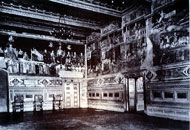|
Allegory of Good Government
Text within the lower border: This holy virtue
[Justice], where she rules, induces to unity the many souls [of
citizens], and they, gathered together for such a purpose, make
the Common Good [ben comune] their Lord; and he, in order
to govern his state, chooses never to turn his eyes from the
resplendent faces of the Virtues who sit around him. Therefore
to him in triumph are offered taxes, tributes, and lordship of
towns; therefore, without war, every civic result duly follows
--useful necessary, and pleasurable.
|
Justice from the Allegory of
Good Government (detail) |
|
Allegory of Bad Government
Text within lower border: There, where Justice
is bound, no one is ever in accord for the Common Good [ben
comun ], nor pulls the cord straight; therefore, it is fitting
that Tyranny prevails. She, in order to carry out her iniquity,
neither wills nor acts in disaccord with the filthy nature of
the Vices, who are shown here conjoined with her. She banishes
those who are ready to do good and calls around herself every
evil schemer. She always protects the assailant, the robber,
and those who hate peace, so that every land lies waste.
|
Effects of Bad Government in
the City
Text with the lower border: ...for the reason
that, where there is Tyranny, there are great fear, wars, robberies,
treacheries, and frauds, she must be brought down. And let the
mind and understanding be intent on keeping each [citizen] always
subject ot Justice, in order to escape such dark injuries, by
overthrowing all tyrants. And whoever wishes to disturb her [Justice],
let him be for his unworthiness banished and shunned together
with all his followers, whoever they may be: thus Justice will
be fortified to the advantage of your peace.
|
|
Effects of Bad Government on
the City |
Effects of Bad Government in
the Country
Text held by Fear: Because each seeks only
his own good, in this city Justice is subjected to Tyranny; wherefore,
along this road nobody passes without fearing for his life, since
there are robberies outside and inside the city gates.
|
|
Effects of Good Government in
the City
Text along lower edge: Turn your eyes to behold
her, you who are governing, who is portrayed here [Justice],
crowned on account of her excellence, who always renders to everyone
his due. Look how many goods derive from her and how sweet and
peaceful is that life of the city where is preserved this virtue
who outshines any other. She quards and defends those who honor
her, and nourishes and feeds them. From her light is borth [both]
requiting those who do good and giving due punishment to the
wicked.
|
Effects of Good Government in
the City (detail) |
|
Effects of Good Government in
the Country.
Over the landscape hovers the figure of security
who holds the following text: Without fear every many may travel
freely and each may till and sow, so long as this commune shall
maintain this lady [Justice] sovereign, for she has stripped
the wicked of all power.
|
|







